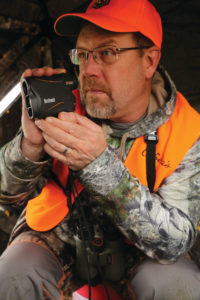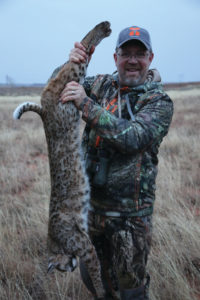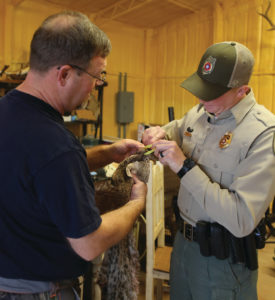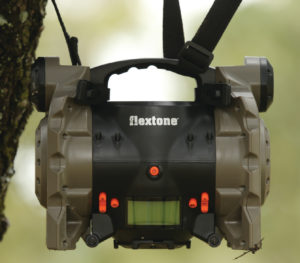Bobcats are stealthy and wary, providing hunters an incredible challenge of their calling and spotting skills. Sometimes even longtime predator hunters have a tough time bagging a bobcat. (Photo: Ralph Hensley)
I sat perfectly still even though some bug was trying to crawl in under the brim of my hat. I was waiting to feel the bite and anticipated having to let the bloodthirsty proboscis have its way with me.
The slight annoyance and distraction didn’t preclude me from catching a glimpse of fur moving through the grass. My heart rate tripled in less than a second, as I watched the reddish-colored hide appear between patches of dense vegetation. I was watching through my scope awaiting my first sighting of a bobcat when a large male gray fox trotted into view.
The red chaps on the flanks of the fox made me believe I finally had a bobcat coming to my predator call, but the gray outer hairs left little doubt it was a curious fox instead.
I have hunted for a bobcat for more than a decade with no luck. I’ve hunted dozens of states and provinces and always purchase the furbearer or small-game license required to harvest a bobcat. I’ve hunted the fall and winter with no positive results. I often feel as though I have a dark cloud hanging over my head when it comes to these spotted felines, and over the years I’ve joked that hunting a bobcat has turned into my hunt for a unicorn. That is, hunting an imaginary creature that doesn’t really exist.
The promised land?
I was invited to the brush country of Texas and was assured we would see several bobcats. The manager of the hunting operation told me, “The ranch is lousy with them.” I was excited but skeptical. I’ve heard lots of the “You should have been here last week” or “we normally see bobcats on a regular basis when calling.” I’ve heard it all, and although hunting unicorns can be a daunting task, I’ve kept at it.

Using a laser rangefinder to establish distances is a plus so you'll have an idea of ranges when a predator comes into view. (Photo: Brad Fenson)
Last year, while hunting deer in Oklahoma, two of the other hunters in camp came in after the first night on stand talking about the bobcats they saw. One spotted what was thought to be a big tom, while the other saw a female with two sub-adult kittens and a big male. I drilled them with questions, and when I started to sound doubtful, I was shown a photograph taken with a trail camera with multiple cats up a tree. My focus changed, knowing I wanted to harvest a deer early so I could head out varmint hunting.
As it turned out, I tagged a beautiful whitetail buck early in the hunt, leaving me three days to concentrate on predators. Todd Rogers, my outfitter at Rut N Strut Guide Services, told me he’d take me to some of his favorite spots to call in an old bob. I rushed to town, purchased the appropriate license and was back in time for a late-afternoon hunt.
We set up about 300 yards from a steep creek bottom, hanging our e-caller on a thorny bush about 75 yards in front of us. We settled into our hiding place and turned up the volume, projecting the hair-raising screech of a jackrabbit in severe distress. The calm prairie air seemed to absorb the wretched sound and carry it to the ends of the earth.
We hadn’t been calling 12 minutes when ears popped over the ridge less than 100 yards away. My heart skipped a beat until I noticed it was a coyote. Todd and I had discussed predators in general, and we weren’t going to pass up a coyote to increase our odds on a bobcat. Besides, Todd reassured me we would find a spotted feline. A well-placed shot anchored the coyote where it stood staring at our noisy thorn bush.
We headed for a wide sweeping draw and set up where we could watch a huge expanse of grassland, as well as two wooded fingers of the creek bottom. We turned on the call and sat back to enjoy the evening. Todd had told me many times that you rarely see a bobcat come to the call, and they just emerge as though they are an apparition.
I was running different scenarios through my mind about where a cat would show up when Todd elbowed me and pointed out a coyote coming over a ridge about ¾ mile away. Our vantage point allowed us to watch things unfold. The coyote wasn’t in a hurry and slowly meandered through the grass, occasionally stopping to lift his nose in the air. It would stop and stare, making me wonder if he was ever going to come any closer. When the big ’yote got to the top of the ridge above the caller it sat down.

It was getting dark and raining when the author killed his bobcat, so photographs were taken in the morning. Hunter orange is required in Oklahoma when hunting predators during the deer season, and was worn at the time of shot. (Photo: Brad Fenson)
It was easy to tell the smart old dog wasn’t going to come any closer with the current setup and Todd whispered that he was going to change the call. The whine of a cottontail kicked up the game immediately, and the coyote came running down the hill towards his easy lunch. I’m not sure if the coyote had an affinity for cottontail or if the sound was just more familiar, but he came fast. At 120 yards, I drilled the coyote and watched it roll down into the creek bottom.
We were out of hunting time for the day, but had planned to be back at it the next morning. Oklahoma’s red soil, eroded creek beds and miles of open prairie equal lots of predators, and I was determined to find a bobcat.
Another day to try
The next morning brought cooler temperatures, and once the deer hunters in camp were taken care of, Todd had me back to call at his favorite feline spots. Like a cat with uncanny senses, I could tell there were felines in the areas we called, and just like the coyote, we had to hit the right notes at the right time to make it happen.
We set up on a draw leading into a creek bottom littered with rocky outcrops and tangles of brush. I knew cats lived in the rough country and snuck in to set up by myself for a calling sequence. I studied the vegetation and rocks in front of me and kept trying to locate the outline of a bobcat that had stealthily come in to watch for his dinner. After 45 minutes, I shut things down and walked to an adjacent draw where I could call to virgin territory.
By the time noon rolled about I had tried three different spots and had yet to find my unicorn. Todd could joined for some afternoon sets, and by dinner time we had run eight different sets since we started our bobcat marathon. I was getting a little forlorn, thinking my usual bobcat luck, or lack thereof, was going to bite me in Oklahoma, too.
Keep trying
We headed close to one of his deer stands where the hunter in camp had seen the four bobcats just a few days earlier. We sat on a high ridge and put the e-caller in the tree the bobcats had climbed a couple of nights previous. I was still oozing with anticipation and felt like this was the right time and place. Close to an hour had expired before Todd looked at me and said, “We have time for one more set before dark.”

Bobcats are on the international CITES list, so anyone transporting one across state lines must obtain a free CITES permit. State game wardens and biologists are helpful for recording the information and providing these tags. (Photo: Brad Fenson)
Heading to the 10th set, with a minimum of 45 minutes spent at each was starting to tire me out. The sky was turning dark, as a prairie storm brewed, and when it started to spit rain my enthusiasm about ever finding a bobcat waned with each passing minute. With the onslaught of rain, we moved to a popup blind overlooking a wide creek bottom. There was a long clay ridge sweeping across the draw in front of us, eroded from years of prairie storms and rain. The site looked too open and desolate for anything to come close, or maybe it was just my disappointment starting to overtake my positive thinking.
We sat in a comfortable chair for the first time in hours and watched the area as a squealing rabbit call translated into “free lunch” in bobcat-speak. As the clouds grew darker, I started to fidget and lose focus, having hunted hard, sitting on stand for over 12 hours. I had stared out the window for what seemed to be an eternity when Todd grabbed my elbow and whispered, “There he is, just left of the caller.”
The old tom had snuck in and was sitting on his haunches, staring at the strange green rabbit-like thing hanging in the shrubs. I couldn’t believe my eyes, or the fact that he entered stage left without Todd or I spotting it. We had no idea how long he had been sitting there, but I guess it was just seconds.
I wasted little time leveling my crosshair on the big bobcat and could hear Todd coaching me to take my time. A deep breath, steady crosshair and gentle squeeze of the trigger cratered the old cat on the spot. The little .222 bullet did its job perfectly, and I couldn’t decide whether to watch the cat through the scope, high-five Todd or run out of the tent.
By the time I got to the cat, I was starting to shake with excitement. It was bigger than I had dreamed of and Todd and I stood in the rain having trouble believing we had finally found a unicorn. Patience and perseverance had paid off with a bobcat that will be hard to beat, no matter how quick or slow the next one comes.
Also know this
The bobcat is listed by the Convention on International Trade in Endangered Species (C.I.T.E.S.) as an animal requiring a permit to possess and export.
Designated animals are listed to ensure that international trade in specimens of wild animals and plants does not threaten their survival. There are restrictions on the export of any animal or plant listed as a CITES species.
Hunters need to know that it is illegal to transport a bobcat across a state, provincial or country border without having a CITES export permit. They are free of charge, and a wildlife officer in Oklahoma was kind enough to come to camp to inspect and tag my bobcat to take home.
Flextone FLX 500 E-Caller
The Flextone FLX 500 holds up to 500 calls and already comes with 100 categorized calls pre-loaded. The three 10-watt speakers on the unit are loud and clear, and project in multiple directions.
Long-range remote-control activation lets you fine-tune volume or change up calls without having to move. The unit and remote have a backlit LCD, making them easy to read. The unit measures 9¾ long x 5¼ wide x 8¼ inches tall and weighs 3.95 pounds. www.flextonegamecalls.com
More top picks from Predator Xtreme:
How to scout in summer for coyotes
3 tips to hunt coyotes the simplest way possible
Coyote 101: Understanding how songdogs rear pups
Wild hogs: A must-hunt species







